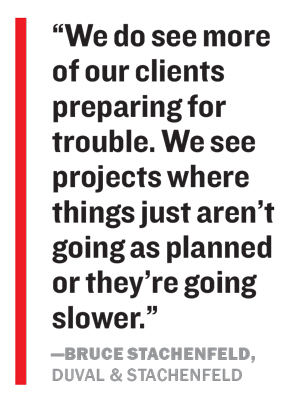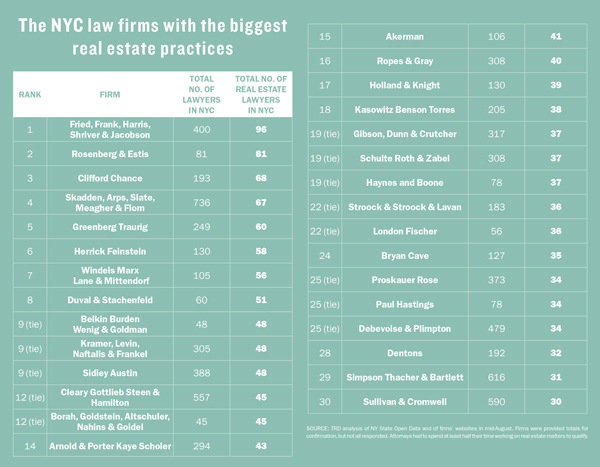Trending
The verdict on NYC’s top real estate law firms
The industry’s biggest legal practices for 2017 and how their caseloads are changing as the market sees more ‘stress’

When upstart developer Bauhouse Group made a daring attempt to retain control of its troubled 3 Sutton Place development site on Manhattan’s East Side, it wasn’t just the firm’s bravado on display. The company’s high-stakes (and ultimately unsuccessful) gamble was also a much-watched legal chess match: On one side were the attorneys for the lender at the white-shoe law firm Kramer, Levin, Naftalis & Frankel, and on the other was the scrappy litigation firm Meister Seelig & Fein, which was representing Bauhouse principal Joseph Beninati.
The case drew the eyeballs of many in New York’s real estate legal community at a time when attorneys say they’re increasingly handling troubled or strained projects.
“You see who comes out on top and how the dust settles,” said Robert Ivanhoe, chair of the global real estate practice at the international law firm Greenberg Traurig, referring to the 3 Sutton deal. “It was interesting to watch the things that lawyers discuss and write about and argue about, [to see] how they evolved in practice.”
Stephen Rabinowitz, chair of Greenberg’s New York real estate practice, agreed, noting that these “occasional high-profile cases” can often highlight an “aspect of the lender-borrower relationship that maybe needs to get tightened up.”
 While New York real estate attorneys are not dealing with distress at levels anywhere near where they were in the wake of the 2008 financial crisis, lawyers at the city’s top firms told The Real Deal that they’re working in an environment that’s showing new signs of stress.
While New York real estate attorneys are not dealing with distress at levels anywhere near where they were in the wake of the 2008 financial crisis, lawyers at the city’s top firms told The Real Deal that they’re working in an environment that’s showing new signs of stress.
Borrowers are modifying loans, lenders are requiring more personal guarantees from borrowers, and clients are looking to protect themselves from financial loss while simultaneously preparing to make opportunistic buys when the time is right.
And all that amounts to plenty of work for transactional attorneys and litigators.
This month, with that new landscape in mind, TRD ranked the city’s biggest law firms by number of attorneys. The early September snapshot found 1,046 real estate lawyers working at the top 20 firms. That’s up more than 4 percent from 1,003 last year and nearly 9 percent higher than the 954 in 2015.
Meanwhile, the top of the ranking saw its own mini shakeup. Global giant Fried, Frank, Harris, Shriver & Jacobson continued adding to its roster and took the No. 1 spot with 96 New York real estate attorneys — up from 78 last year.
And last year’s No. 1 firm, Rosenberg & Estis, scaled back its aggressive growth and snagged the No. 2 spot with 81 real estate attorneys.
Those firms were followed by Clifford Chance (with 68 New York real estate attorneys), Skadden, Arps, Slate, Meagher & Flom (with 67), Greenberg Traurig (with 60) and Herrick Feinstein (with 58).
Lawyers at those firms and others, who have spent the last several years billing clients for work on buying and selling buildings, are finding that they must adapt to a market where those deals, while still happening, are fewer and farther between.
While lawyers last year were also reporting a slowdown in monster deals, this year attorneys at the top firms are busier working on complex litigation cases and have clients who are racing the clock as the market continues to slow.
Dan Altman, a partner at Belkin Burden Wenig & Goldman, said his firm added only one attorney, who will focus on office leasing — which is still seeing a healthy amount of activity — and retail to make up for the lack of work the firm is handling on multifamily sales, which have plummeted.
“During these less active times in one area of your practice, I think you need to go back your clients and find out what they’re busy with and address those needs,” said Altman, whose firm tied for No. 9 with 48 real estate attorneys.
‘Preparing for trouble’
While 3 Sutton Place is a mess, it isn’t the only high-profile project making headlines. On Billionaires’ Row, JDS Development Group and Property Markets Group have been battling with lenders at their planned supertall condo at 111 West 57th Street, which is facing cost overruns. And at 2 Herald Square, the long-warring Sitt brothers have been clashing in court over control of the property.
But attorneys said these buildings are the exception, not the rule in today’s market. What’s more common, they said, are financially strained projects being recapitalized with new partners and new infusions of cash.
“We’re starting to see the first inclinations of stress, instead of distress,” said Jonathan Adelsberg of Herrick Feinstein. Sponsors at new development projects in particular, Adelsberg said, are being forced to renegotiate purchase prices, delay closings and extend the terms of their loans with lenders.
Belinda Schwartz, chair of Herrick’s real estate department, said deals need a lot more legal work and a “lot of brain damage.”
“Even though you might see fewer deals, they require a lot more putting-together and curating, kind of like a Rubik’s Cube,” she said.
Still, the number of foreclosure starts across the city is actually down. In the past year, there were 8,901 residential and commercial foreclosure cases initiated in the five boroughs — down 15.2 percent from the previous year, according to figures from national real estate property firm ATTOM Data Solution.
One reason fewer projects are falling into foreclosure, experts said, is because borrowers and lenders are increasingly modifying loans or joint-venture agreements before they get overextended. And all of that takes legal work.
“We do see more of our clients preparing for trouble,” said Bruce Stachenfeld, founding member of the firm Duval & Stachenfeld, which took the No. 8 spot on the ranking with 51 real estate attorneys.
“We see projects where things just aren’t going as planned or they’re going slower,” added Stachenfeld, whose firm specializes in joint ventures.
Across the city, a slowdown in the high-end luxury market, declining hotel revenues and high vacancy rates for retail properties are taking their toll on projects and adding to the workloads of lawyers.
“The workouts we’re doing now are not like the catastrophe we had in ’07 and ’08,” said Wally Schwartz, co-managing partner of the No. 18-ranked Kasowitz Benson Torres. “The properties are still basically viable. Sales have slowed down in situations where the project needs a little more time and a bit more money.”
And much like last year, attorneys said also they’re busy helping clients set up opportunistic and distressed funds, suggesting that investors are still preparing to pounce and scoop up properties if the market drops further.
But Evan Levy, head of the real estate capital markets practice at Skadden, said there still haven’t been many distressed opportunities, given the strong financing markets.
“We see fund sponsors developing their investment strategies to capitalize on more attractive prospects when the cycle inevitably turns,” he said.
Investors Steve Witkoff and Michael Ashner, for example, recently teamed up to launch a $150 million investment fund that will consider distressed deals such as loan acquisitions, underperforming real estate and development projects.
And Delshah Capital plans to raise a $200 million fund to focused on distressed investments.
Closed-end private equity funds focused on distressed assets in North America have, indeed, raised $10.8 billion in 2016, according to the alternative-asset research firm Preqin. That’s $8.7 billion more than the two previous years combined.
All that blood in the water can be a feeding frenzy for the sharks who work on distressed deals, including the lawyers.
Daniel Stanco, an attorney at the firm Ropes & Gray, said he and partner David Djaha launched the international firm’s New York real estate practice in 2009, which he said was “definitely not the best time for real estate lawyers.”
But, he said, what helped get the firm get through that period was its focus working with investors who dealt in distress. The firm, which ranked No. 16 with 40 New York real estate lawyers, is now rolling out training programs for associates to educate them on those hairier deals.“You have to be prepared for those days,” he said.
New cash cows
A complicated development deal can be a cash cow for real estate lawyers, who work on everything from the acquisition to the financing to the land-use negotiations.
“A big development project is a massive consumer of real estate law services,” said attorney Joshua Stein, who in 2010 launched his eponymous firm focusing on financing and acquisitions, which did not make the ranking.
“Development is the coolest part of real estate law, and that’s what makes the really big practices boom,” he added. “It’s complicated, it’s interesting, it’s sophisticated [and] the numbers are so big.”
But the firms that focus on development projects are finding slightly fewer new ones in the pipeline. In the 12-month period ending August 30, the city issued 891 building permits, down about 2 percent from the previous year, according to a TRD review of filings at the Department of Buildings.
But far more dramatic has been the falloff in commercial real estate transactions. At the halfway point of the year, Manhattan sales volume was down 55 percent, according to Real Capital Analytics.
“Clearly there aren’t as many trades going on,” said Steve Gliatta, chair of the real estate practice at Arnold & Porter Kaye Scholer, which ranked No. 14 on the list with 43 attorneys. “Having said that, if somebody’s holding assets or repositioning or recapitalizing them, there still is a lot of financing activity going on.”
When the financial crisis hit in 2008, banks stopped lending, and the law firms working on the debt were hit especially hard. But today those same firms say that despite the sales slowdown they are busy because borrowers are refinancing their properties.
Others said they’re shifting resources toward corporate real estate deals, where instead of buying into properties, investors buy part of a company.
“The parties to a corporate real estate transaction may be in New York City, but they’re lending nationwide,” said Stachenfeld, of Duval & Stachenfeld, whose firm represented NorthStar Realty Finance in a $340 million investment in RXR Realty. Such relationships, he added, can help a firm buoy business when the New York market is slow.
“It’s not necessarily dependent on New York City deal volume,” he said.
And despite the slowdown on the sales side, firms said they’ve been busy with office leasing. Leasing activity in Manhattan through the first six months of the year stood at 17.8 million square feet, according to Colliers International. While that was flat compared to a year earlier, attorneys who focus on leasing said there’s still a healthy amount of work, particularly at new office towers at the World Trade Center and on the Far West Side.
Related Companies and Oxford Property Group, for example, use three law firms for leasing at Hudson Yards: Fried Frank along with Gibson, Dunn & Crutcher for office leasing and Kasowitz Benson for retail.
And that’s in addition to the attorneys representing the tenants.
“A new development on the scale of Hudson Yards is so large that it generates a steady stream of leases to be addressed,” said Andrew Lance of Gibson, Dunn, which tied for No. 19 with 37 New York real estate lawyers.
Winner, winner chicken dinner
This year saw a changing of the guard among the firms with the most New York real estate attorneys.
Fried Frank bucked the slower-growth trend, which is what landed it the No. 1 spot. It increased its headcount 23 percent, jumping to 96 attorneys this year from 78 last year. The firm also added 13 attorneys last year — more than any of its rivals.
“We’ve been certainly in an expansive mode,” said Jonathan Mechanic, the gregarious chair of the firm’s real estate practice. “We’ve expanded to accommodate client demand, and that demand still is there.”
Mechanic said his firm had an incoming class of nine new attorneys and added new partners in corporate real estate, finance and real estate litigation.
The firm represented SMI USA, the U.S. subsidiary of Shanghai Municipal Investment, in its equity investment in Gary Barnett’s Central Park Tower condo project last year. SMI, the largest state-owned enterprise in Shanghai, has thrice extended the deadline for a put option that would give it the right to buy the site as Barnett looks to secure more financing.
Earlier this year, Fried Frank also repped BlackRock in its 750,000-square-foot lease at 55 Hudson Yards.
And sources say Mechanic is ever the rainmaker. One industry player said there’s a well-circulated rumor that Mechanic has his own publicist. “Jon Mechanic manages to keep an incredible amount of real estate lawyers busy,” the source said. “I think he has a full-time PR person, and the joke is that he has a full-time photographer.”
But not everyone thinks now is the time to be aggressively adding to their overhead.
Rosenberg & Estis added just one attorney this year, giving it 81 lawyers, compared to a net gain of eight last year. Between 2014 and 2015, the firm grew by a massive 64 percent, jumping up to 72 attorneys from 44. But managing member Luise Barrack, who spearheaded the firm’s expansion and helped transform it from focusing on landlord-tenant issues to a full-service firm, said the scaling back was strategic.
“I think things have leveled off,” she said. “We’re not prepared to grow at the same pace year over year.”
Rosenberg & Estis partner Michael Lefkowitz said the company’s growth depends on the health of the sales market.
“I think we all recognize that real estate is not being traded or transacted at the same exuberant level it was being done a few years ago,” he said.
Research by Ashley McHugh-Chiappone





